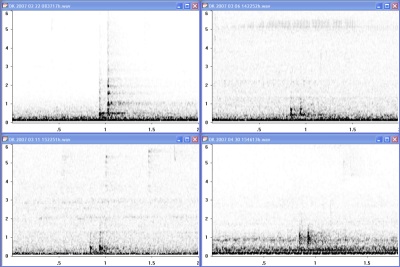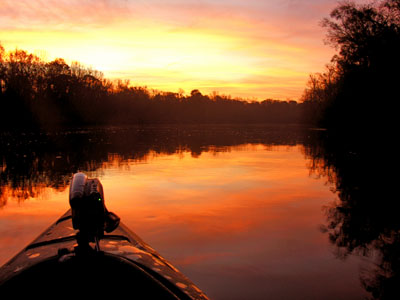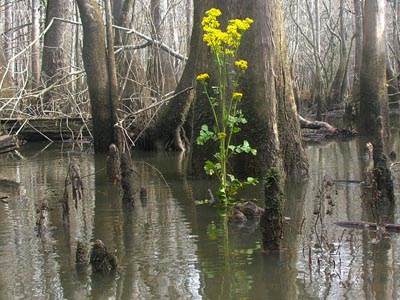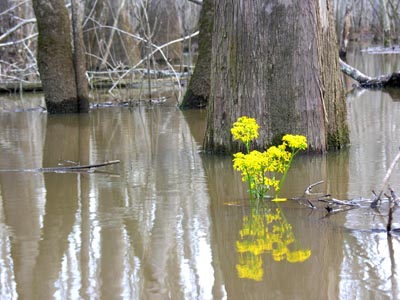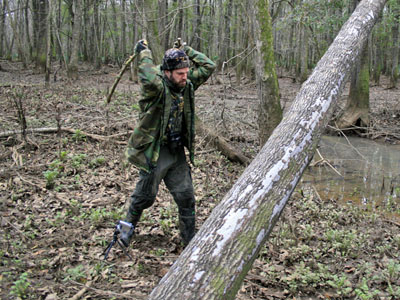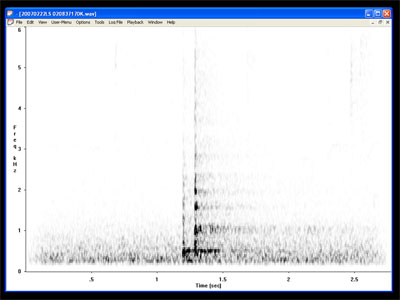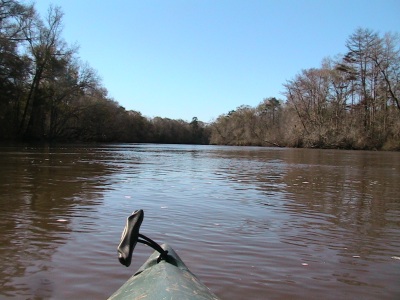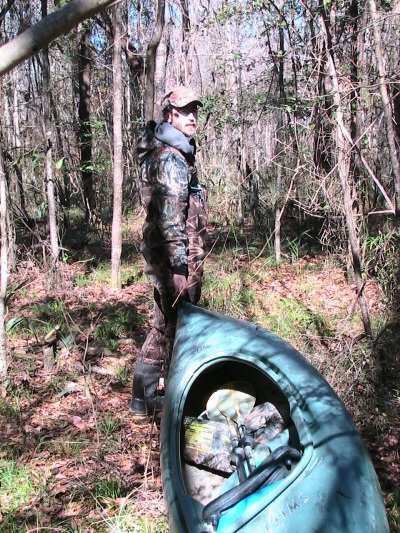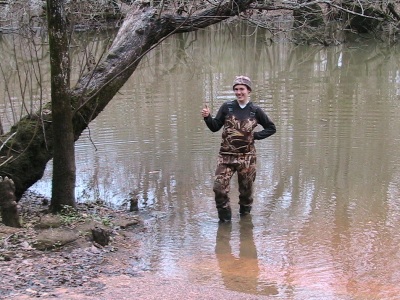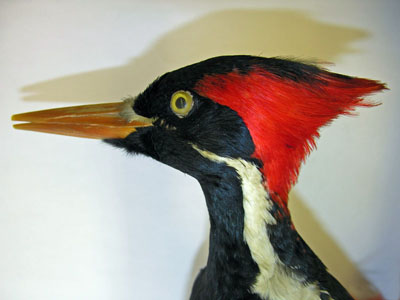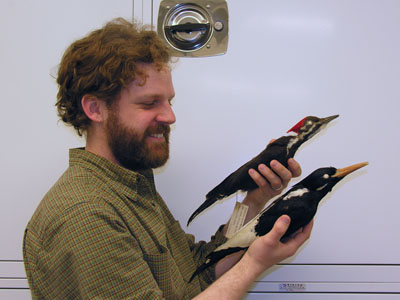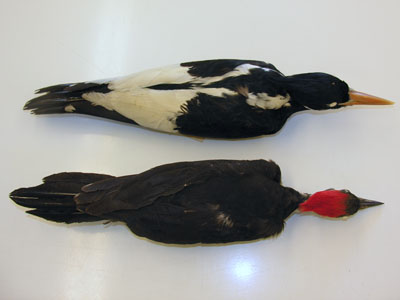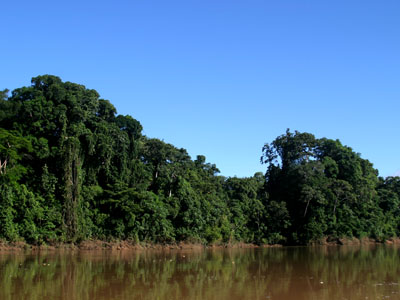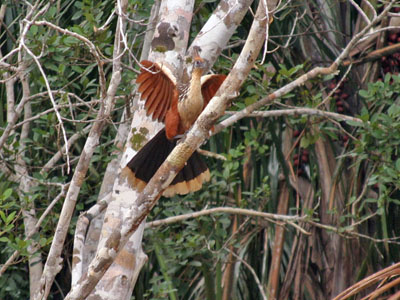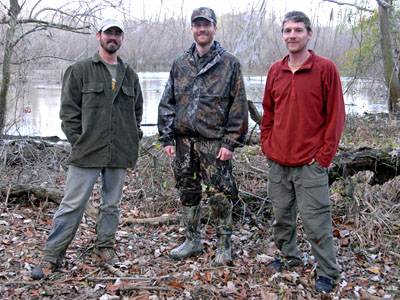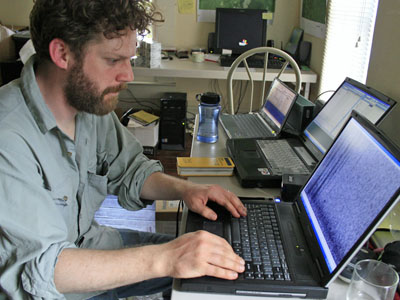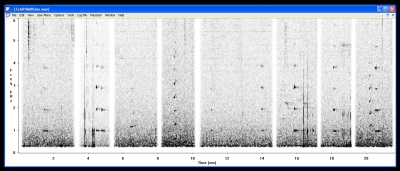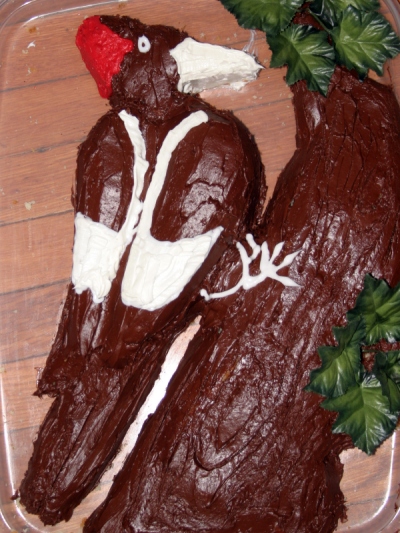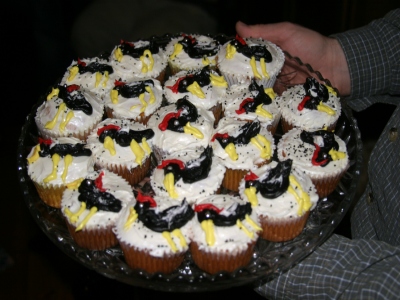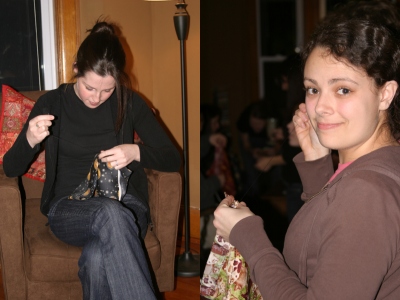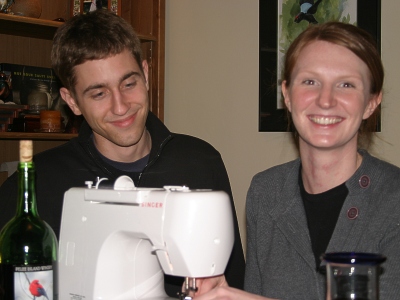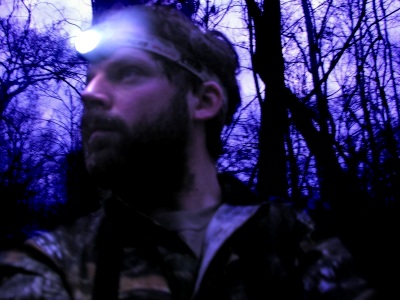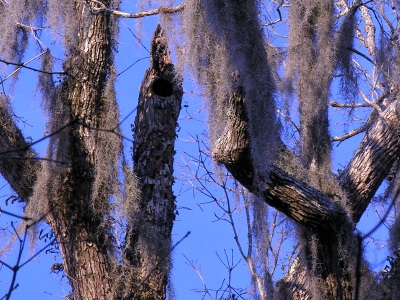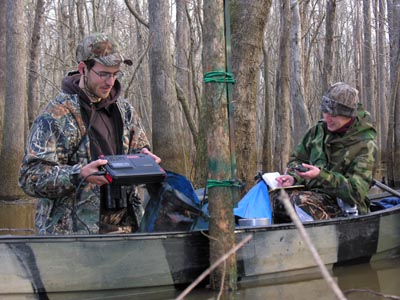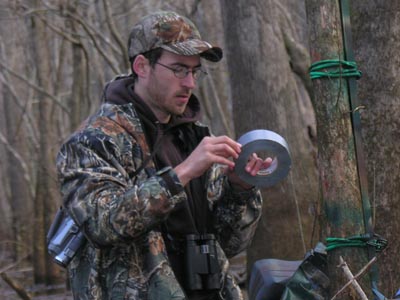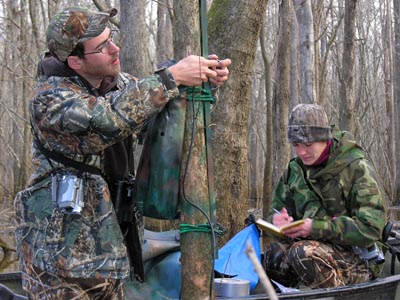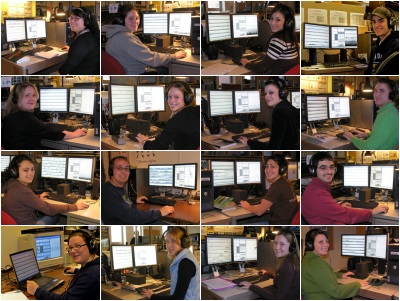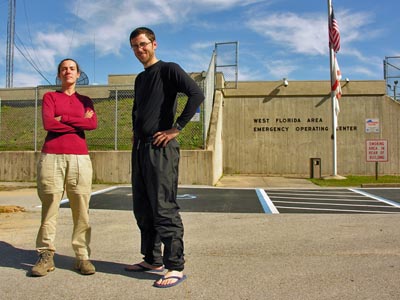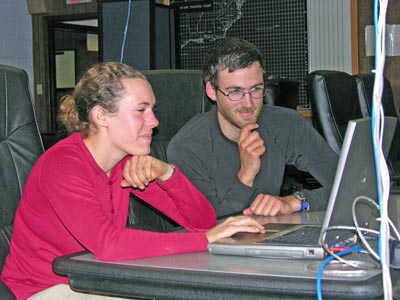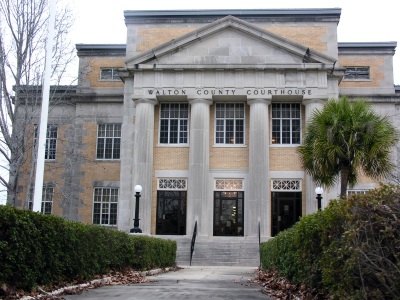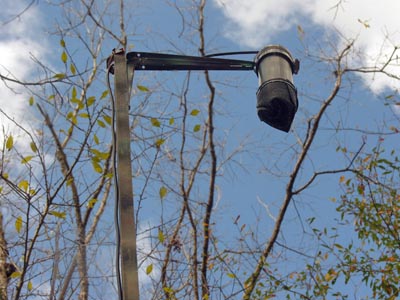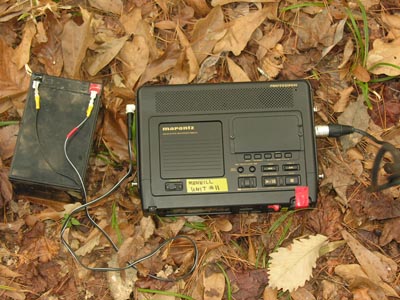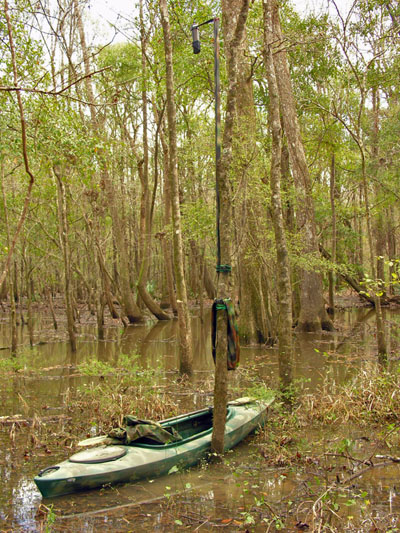|
|
|||||||
               |
|||||||
| THURSDAY AUGUST 15, 2007 Double Knock Playback at the A.O.U. I have returned from a
great meeting of the American Ornithologists' Union (AOU) at the
University of Wyoming in Laramie. The meeting was attended by
more than 500 ornithologists from throughout the world, and featured
some very interesting presentations (my favourites included symposia on
manakins and lekking behaviour, and on the taxonomy of the
nine-primaried songbirds).
At the AOU meeting, Geoff and Brian presented some of the results of our 2007 search for Ivory-billed Woodpeckers on the Choctawhatchee River. Brian provided details of one of his encounters from last summer, including presentation of a grainy video of a bird that he identified in life as an Ivory-billed Woodpecker. Geoff highlighted the sightings and acoustic encounters made by members of our search team over the last year, and displayed an image from one of our 315 deployments of automated cameras. Geoff's presentation also included playback of four of our best recordings of putative double knocks from the 2007 search. As we complete the report on our 2007 search, I am readying all of our recordings to post on this website. In the mean time, I will post the four sounds that Geoff played back to the audience at the A.O.U. meeting: Click on the dates below to listen to the recordings: (1) February 22, 2007 at 08:37 (top left spectrogram) (2) March 6, 2007 at 14:22 (top right spectrogram) (3) March 11, 2007 at 15:22 (bottom left spectrogram) (4) April 30, 2007 at 15:46 (bottom right spectrogram) As soon as it is
complete, we will post our report on the 2007 search for Ivory-billed
Woodpeckers on the Choctawhatchee River, Florida. It will include all
of our putative double knocks and kent calls.
|
LINKS Dan Mennill's Homepage Geoff Hill's Ivorybill Website Mark Bailey's Choctawhatchee Search Blog Avian Conservation and Ecology (ACE-ECO) RESOURCES Choctawhatchee Weather Forecast Choctawhatchee River Level UPDATES Aug 14: Double Knock Playback at the A.O.U. June 27: End of the Field Search March 31: Rising and Falling of the Choc March 25: Choc full of Double Knocks March 20: A Place to Land March 16: Ivorybills in Michigan March 13: One Flooding River to Another February 11: Richard's Kent Encounter February 4: Cups and Cakes January 28: Woodpecker Emerging from a Roost Cavity January 24: The Daily Swap January 21: The Lost Technician January 20: The Secret Underground Lair of the Ivorybill January 17: Courthouse to the Rescue January 15: What's in a Listening Station? January 13: The Search Begins |
||||||
| WEDNESDAY JUNE 27, 2007 The End of the 2007 Field Search For the past two months,
while I have been living in the dry forests of northwest Costa Rica
studying the vocal behaviour of neotropical wrens, our 2007 field
search for the Ivory-billed Woodpecker has drawn to a close. I've
returned to my sound analysis laboratory at the University of Windsor
to find Kyle and Karan hard at work processing the massive collection
of recordings that we gathered in 2007. In total, we collected
more than 35,000 hours of digital recordings between early January and
late
May. To my knowledge, this is the largest dataset of its kind in the
history of sound recording! By the end of May, the seventeen-member
sound analysis team had scanned approximately 25,000 hours of these
recordings before we exhausted the generous financial contributions of
the
granting agencies and private donors who have supported the search over
the last year.
We are now in the process of collating and ranking all of the positive detections collected by the sound analysis team, while we continue to scan through the last 10,000 hours. Within the coming months we will write a report on all aspects of our 2007 search, including the bioacoustic efforts of my team as well as the efforts of the search team and camera team lead by Geoff Hill. I will post a copy of this report here as soon as it is complete. 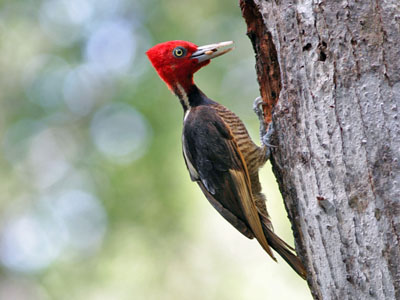 At my study site in
Guanacaste Conservation Area in northwest Costa Rica, Pale-billed
Woodpeckers are abundant. Over the past two months, during my ongoing
studies of wrens,
I found an active Pale-billed Woodpecker nest and had the opportunity
to study the behaviour of the parents. In these two photos, the
adult male Pale-billed Woodpecker delivers food to the young female
nestling growing inside.
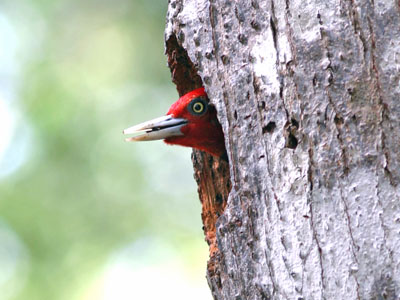 In the absence of
extensive historical recordings of the sounds of Ivory-billed
Woodpeckers, analysis of the recordings I made of these Pale-billed
Woodpeckers in Costa Rica will help focus our understanding of the
recordings we made in Florida over the last two years.
As the sun sets on the
2007 search for Ivory-billed Woodpeckers on the Choctawhatchee, I am
very thankful to the hard work devoted to the project by the 2007
Ivory-billed Woodpecker search team. Our Florida search would not have
been possible without the generous financial support of the people and
agencies listed on my Partners page. In
particular, I am very thankful to Pelee Island Winery; their support
allowed us to achieve 24-hour turnaround while scanning through most of
this year's recordings. I am thankful to the seventeen-member sound
analysis team for their dedicated efforts, and Kyle Swiston for
organizing the bioacoustic search on campus at the University of
Windsor. I am also very thankful to the dedicated effort made by the
field team, especially Karan Odom and Justyn Stahl who maintained the
listening stations through a long field season, and Wally Rendell who
provided invaluable assistance to Karan and Justyn in May.
Thanks to David Bradley for the Pale-billed Woodpecker photos in this posting. |
|||||||
| SATURDAY MARCH 31, 2007 The Rising and Falling of the Choc The
Choctawhatchee River ("the Choc" to the syllabically
conservative) carries rainfall collected over a substantial section of
the
Florida panhandle and a large section of southeastern Alabama. The
river is not regulated by any major dams. When a rainstorm hits,
the water level on the Choc rises, sometimes by as much as a foot or
two per day.
In the winter,
everything on the Choc is brown with a hint of green. When a colourful
flower pops up, it catches your eye. One morning
on my travels between listening stations, I snapped this photo of a
tall yellow flower that
stuck out three or four feet above the surface of the water. My
botanist friend Brandon Schamp tells me it looks like
some species of mustard.
That night, we received
a very heavy rain; the kind of rain that doesn't let up for hours
on end. The next morning, as I passed by the flower, I noticed that the
water level didn't appear to have risen much. But by the
following morning, as the water collected in the Choc from all of its
tributaries, the river had started to rise. Two mornings
later, I took another photograph of the same plant.
As the river rose almost
three feet over 48 hours, this plant came close to total
submersion. But as the water water receded, the plant began to
stand tall once again. It is an organism that is obviously
well-ada1pted
to life in a flooded forest.
|
|||||||
| SUNDAY MARCH 25, 2007 Choc full of Double Knocks We've had a lot of
acoustic detections of Ivory-billed Woodpeckers so far in this year's
search of the Choctawhatchee River. Recently we've had some very
compelling detections, both by searchers in the swamp and by the sound
analysis team at the University of Windsor.
On March 6, Dr. Ken Able, professor emeritus at SUNY Albany, visited a part of the Choctawhatchee outside of our formal search area. An expert on southern birds, Dr. Able heard kent calls and was "convinced that they were made by an ivory-bill". The following day two more searchers returned to the area, Dr. Bill Summerour and Eric Soehren. They simulated double knocks and Eric heard a double knock given in response that reminded him of "a Magellanic Woodpecker double knock." More details of these encounters are provided in full at Geoff's update site. We are presently moving some of our Listening Stations to this apparent hotspot. While studying Pale-billed Woodpeckers in Costa Rica, I found that simulating double knocks sometimes attracted woodpeckers. To simulate a double knock, I used two sticks as wide as broom handles, both about two feet long. Lifting them overhead and bringing them down with full force on a resonant hollow log produced an accurate rendition of a double knock. This type of simulation was far more effective than playback through my portable loudspeakers, which are not capable of producing a double knock with sufficient amplitude. Throughout our 2006 search and the early part of our 2007 search on the Choctawhatchee, we did not simulate double knocks or kent calls in our search for Ivory-bills. This allowed us to be confident that any sounds recorded by our listening stations were not produced by humans. Bill and Eric's double knock response on March 6 demonstrates the promise of the simulated double knock approach, which we are now using tactically throughout our search area. By keeping very careful records, including the exact GPS coordinates and the exact GPS time (to the second) of any simulated sounds, we will avoid the pitfall of mistaking ourselves for Ivory-billed Woodpeckers. Our Listening Station recordings have continued running smoothly, with all 16 stations running full time. We are limited by bandwidth capacities between Florida and Windsor, but we are achieving 24-hour turnaround on scanning more than half of our recordings. The remaining recordings get transferred from Geoff's office at Auburn University with a one to three week delay. This week, as my Windsor-based sound analysis team scanned through some of these back-logged recordings, we came across one of our most impressive putative double knocks from this year's search. Click here to listening to this impressive double knock from February 22 (spectrogram depicted below). This recording was made
at 08:37 in the morning. Three hours later, an adjacent Listening
Station recorded this
putative double knock. Ninety minutes later, that
same Listening Station recorded another
putative double knock. In
the two later recordings, the sound source is much farther away
from our microphone, resulting in a lower signal-to-noise ratio.
Nevertheless, all three sounds are consistent with Tanner's description
of Ivory-billed Woodpecker double knocks.
Special thanks to Steve Pike for the photographs in this posting. In other news, I have
greatly enjoyed speaking with the Blue Water Audubon Society,
the Grosse
Pointe Audubon Society, the Richmond
Hill Field Naturalists, and the West Humber Field Naturalists
over the last month. Thank you for your warm hospitality and your
ongoing interest in the search for the Ivory-billed Woodpecker in
Florida.
|
|||||||
| TUESDAY MARCH 20, 2007 In Search of a Place to Land GUEST POSTING BY KARAN ODOM By far one of the most
challenging aspects of this field season to date has been logistics.
Okay,
maybe not as difficult as getting a picture of an Ivory-billed
Woodpecker, but trying to organize a daily routine for organizing the
listening stations has proven
pretty tough.
Special thanks to Karan Odom for this guest update,
and to Karan Odom and Justyn Stahl for the photographs in this posting.Our equation is this: two people, two kayaks, multiple destinations and listening stations, and just one vehicle. With the obvious limiting factor of our single van, Justyn and I spend a good portion of each day conducting drop-offs and pick-ups at various places along the Choctawhatchee in order to swap out batteries and memory cards from the Listening Stations each day. In our most brilliant scheme yet, one person floats down the river of the northern portion of the site while the other person floats the southern part of the site, each changing out stations as they go. Meanwhile, the van is parked in the middle for easy jockeying of both people and kayaks. Nonetheless, another challenge presents itself: finding the perfect rendez-vous locations. We have used two primary landings for some time, but in anticipation of re-deploying Listening Stations into a new area, we began to search for a new landing. After asking around, Justyn and I drove to what we thought was the best choice. “Yes!” we thought upon arrival. The GPS showed it was exactly the distance we needed for the new Listening Stations. So, we jumped back in the van, I dropped Justyn off up north, parked the van in the middle and began my test run down the main Choctawhatchee to the waypoint of my new landing. The float was peaceful and I scoped out several nice stands of old cypress trees, perfect for placement of Listening Stations! However, about a kilometer past my waypoint and about ten minutes until I was supposed to meet Justyn at our new destination, I began to worry. Where was the cut-in to our new landing? Just then a voice came over the radio. “Hello Karan," Justyn's voice crackled over the radio. "My GPS shows you’ve passed the landing. What’s up?” he asked. After explaining that there didn’t appear to be a cut-in, Justyn jumped in his kayak and headed out from the landing. Sure enough, every little creek he tried led to dry land. Desperate to avoid paddling kilometers back up the main river against its speedy current, Justyn came to my rescue by hiking through the woods to the main river. We then hoofed it back to Justyn’s kayak, with my kayak in tow. Already too late in the day to try another landing, we left further exploration for the next morning. Bright and early the next day, I dropped Justyn off up north, again, and I began searching every back road in the southern portion of our north Florida site; an adventure in its own right. Forty-five minutes later, I found another landing. Once again just the distance we needed to accommodate new Listening Stations, but would it connect? This time, I attempted the search from the opposite approach. I hopped in my kayak and paddled toward the main channel from the landing. Not only did this prove a better tactic, but a greater success. Just a short jaunt around the corner and there it was: the rushing main Choctawhatchee! I give a thumbs-up to our landing dilemma solved and our logistics equation complete! |
|||||||
| FRIDAY MARCH 16, 2007 Ivory-billed Woodpeckers Photographed in Michigan Today I finally
succeeded in photographing an Ivory-billed Woodpecker. However it
wasn't in Florida, as expected, but in Michigan.
Occasionally I get to
accompany my wife on expeditions to various museums throughout the
world. She studies the ecology and evolution of plumage coloration in
birds and she visits museums to measure the colour of museum specimen
feathers. These trips are a lot of fun for me because I get to explore
the collections and marvel at the tremendous diversity of birds
produced by the last 200 million years of evolution.
The skin collection at
the University of Michigan, just across the border from the University
of Windsor, is one of the larger collections in North America. Among
their holdings are nine Ivory-billed Woodpecker specimens dating from
as early as 1869 and as late as 1907.
Holding an Ivory-billed
Woodpecker in my right hand and a Pileated Woodpecker in my left hand,
I was reminded me how similar these birds are in size, but how
differently these two species are built. The Ivory-billed is a
bulky and substantial bird with an impressively large head and bill
compared to the Pileated.
Here I've photographed
the skins of a female Ivory-billed Woodpecker (top) and a female
Pileated Woodpecker (bottom). On December 24, 2006, at the start of our
current search for Ivorybills on the Choctawhatchee River in Florida,
Tyler Hicks had a clear look at a female Ivory-billed Woodpecker. Tyler
noted several of the features that you can see here clearly in the
Ivory-billed Woodpecker but which are absent in the Pileated
Woodpecker: An all-black crest, a pale-coloured bill, an all-white
lower portion of the back, and a white stripe running from the neck
down the back.
By the end of this year's search, I hope to be able to show you photographs of the birds we continue to encounter in Florida, looking much more animated than these. Special thanks to the staff, faculty, and students at the University of Michigan Museum of Zoology for hosting a great visit from the ornithology team at University of Windsor. |
|||||||
| TUESDAY MARCH 13, 2007 From One Flooding River to Another I have just returned
from another flooded river wilderness whose forested banks resonate
with the sounds of double knocking woodpeckers.
This particular river is much farther south than the Choctawhatchee and
is the largest river in the world.
It is a tributary of the
Amazon called the Tambopata River in southeastern Peru. Over the last
three weeks I was co-teaching a class on the Tropical Ecology of
Amazonian Peru to twenty-one Ontario university students (more pictures
available here.) The
lowland forests of eastern Peru are home to the Red-necked Woodpecker (Campephilus rubricollis), a sister
species to the Ivory-billed Woodpecker. Red-necked Woodpeckers produce
a double rap display that matches Tanner's descriptions of the
Ivory-billed Woodpecker's double knocks. Hearing these woodpeckers gave
Kyle and I a chance to sharpen our ears and to collect more Campephilus recordings to compare
against our Florida recordings.
The bird life in Peru is fantastically diverse. The oxbow lake at our jungle lodge, the Explorer's Inn, was home to this most unusual bird, the Hotazin. Both the Florida field
team and the bioacoustics team in my laboratory at the University of
Windsor have been very hard at work while I was out of communication.
We officially surpassed the total number of hours recorded that we
collected over the entire search last year: 11,500. It think this makes
our 2007 Choctawhatchee recordings the largest dataset of continuous
sound recordings ever collected.
The technicians have isolated many kent calls and double knocks over the last three weeks and they have shared these with Geoff and Karan and Justyn and the rest of the field team in Florida. In the coming week, we will carefully assess and measure these detections. Our field team had two sightings in my absence, but we still haven't obtained a clear photograph or video. I hope that our ongoing recordings will help us to locate the birds as their expected nesting season progresses. Special thanks to David Bradley for the two photos in this posting. |
|||||||
| SUNDAY FEBRUARY 11, 2007 Richard Martin's Kent Encounter In the mid-morning of
February 1, 2007, Ivory-billed Woodpecker search volunteer Richard
Martin heard a
sound that caught his attention. As he paddled a creek off the main
channel of the Choctawhatchee, Richard heard a nasal sound that
reminded him of the written description of Ivorybill kent calls and of the recordings of
putative kent calls that we
have made on the Choctawhatchee in 2006 and 2007.
Richard is pictured here on the bank of the Choctawhatchee River with Tyler Hicks (left) and Brian Rolek (right). Although this acoustic encounter did not result in a sighting, Richard had his video camera rolling as he heard these kent-like sounds, and he even had an external microphone mounted on his camera. He sent the video to my crew, and I isolated the audio track. Over a period of 7 minutes and 50 seconds from Richard's video recording, there are 11 kent-like sounds with stacked harmonic structure. You can hear the sounds by clicking here, and you can see a spectrogram of the recording below. Note that I have removed the quiet intervals between the consecutive sounds in this sound file, and I have filtered out the background noise below 250 Hz. The 11 sounds vary between two pitches. There is a single kent-like sound at a higher pitch, then a double note at the same pitch, then two single kent-like sounds at a lower pitch, then four more single kent-like sounds at the original pitch, and the a doublet of a low-pitched then high-pitched kent-like sound in rapid succession. The last four sounds are substantially louder and more powerful than the first seven. I asked Richard to tell me more about the encounter, including the wind conditions and the location of the sounds. Richard explained: "The sounds were heard at 1023 AM. There was very little wind. The sounds were to the southwest of my position. I think that it is difficult to judge the distance of sound in the swamp. My impression was that I was going to see movement at about 75-125 meters." When I asked him if the sounds seemed to be coming from a stationary source or a moving source, Richard said "There seemed to be some movement of the sounds, but the general direction of origin was always southwest." We have started to pick up more putative kent calls through our Listening Stations in the last week, as well as a few putative double knocks. Is this the start of the breeding season of the Ivory-billed Woodpecker? Special thanks to Steve Pike for the photographs in
this posting. Thanks to both Richard and Steve for their dedication as
volunteer Ivorybill searchers.
|
|||||||
| SUNDAY FEBRUARY 4, 2007 Ivory-billed Woodpecker Photographed... In Both Cake and Cupcake Format We have completed almost
one month of bioacoustic research on the 2007 Ivory-billed
Woodpecker expedition. The
sound analysis team in the Mennill Lab at the University of Windsor is
putting in long hours scanning all of the recordings sent from the
field site in Florida, so we decided to have a party. Are you wondering
what Ivory-billed Woodpecker research technicians bring to a party?
Sound analysis technicians Ellen Green and Holly Hennin made an ivorybill cake depicting a tasty male ivorybill perched on a delicious cypress tree. Sound analysis technician Claudia Bustos, on the other hand, opted to bake a flock of bite-sized ivorybill cupcakes, each featuring a male ivorybill with a silvery eye (which bore a remarkable resemblance to the eyes of an Australian Red-backed Spider). Our glimpses of these Ivory-billed Woodpeckers were fleeting, and within just a few minutes neither the cake or the copcakes could be relocated. Both the cake and the cupcakes were complemented by a nice cabernet from Pelee Island Winery, our sponsor for the 2007 bioacoustic search. Never ones to be caught dilly dallying, the Mennill and Doucet lab students also made bird bags at the party, for use on upcoming expeditions to Peru and Costa Rica. Some folks sewed bird bags by hand, including Mennill Lab Honours student Sarah Tremain and sound analysis technician Holly Hennin (above). Others used a sewing machine, including Mennill Lab Honours student Sarah Lippold and grad student Kyle Swiston (below). Sarah's seamstress skills proved speedier than everyone else's hand sewing skills. Thanks to Sarah's mom for loaning us her sewing machine! The irony of using a Singer sewing machine at an Ivory-billed Woodpecker party was not lost on us. Special thanks to David Bradley for the photographs in this posting. |
|||||||
|
SUNDAY
JANUARY 28, 2007
Woodpecker Emerging from a Roost Cavity Late one afternoon, as I hiked around my study site, I found a large cavity in a fresh snag. It was an oblong cavity, taller than it was wide, and it reminded me of James Tanner's description of an Ivory-billed Woodpecker cavity. Early the following morning, before the first light of dawn, I snuck up on the cavity and shot the following video: This was at my study
site at Santa Rosa National Park within the Guanacaste Conservation
Area in Costa Rica. The bird was a Pale-billed Woodpecker (Campephilus guatemalensis), a
smaller, tropical relative of the Ivory-billed Woodpecker. Each morning
this female emerged from her roost cavity, climbed to the top of the
roost tree or a nearby tree, gave one or more double knocks, and then
flew off. Early morning was the only
time of day that I could reliably locate a Pale-billed Woodpecker... by
staking out a roost cavity.
Our search team in Florida has found many large cavities along the Choctawhatchee River. As we reported in our recent publication in the journal Avian Conservation and Ecology, many of these cavities exceed the maximum dimensions of the cavities of Pileated Woodpeckers. This year we are surveying all cavities along the Choctawhatchee and monitoring the largest ones very closely. In the early mornings, I try to monitor large cavities en route to our Listening Stations. Sneaking up on a cavity before dawn in a flooded forest is not easily done. But by GPS'ing a path during daylight hours, and charging the batteries in my headlamp to full, I found it possible to quietly sneak up on a cavity for a stake-out. None of my early morning
stake-outs in Florida have given me a glimpse of a roosting bird.
However, we'll keep watching and photographing these cavities. They may
represent our best chances of getting a photograph or video of an
Ivory-billed Woodpecker.
|
|||||||
|
WEDNESDAY
JANUARY 24, 2007
The Daily Swap Record sounds in remote flooded forest in Florida. Transmit the recordings more than 1500 kilometers to the University of Windsor. Within 24 hours, run a detailed spectrographic search of all recordings for Ivory-billed Woodpecker sounds. Repeat every day. This is the formula of the University of Windsor Ivorybill bioacoustic team. One of the challenges to this approach is that each of our Listening Stations must be visited on a daily basis to retrieve the recordings. Karan and Justyn, the Bioacoustics field crew, have made an efficient science of the daily swap. Each morning they visit each listening station and swap the memory cartridge and the battery. When the water is high, they swap from the canoe. When the water is moderate, they swap from kayaks. And when the water is low, they swap on foot. Here Justyn swaps out the full memory card from the Marantz digital recorder, while Karan records details of the stop time, the location, and the date. As with any good field
biology project, duct tape plays a key role. On the Ivorybill search,
duct tape serves to make sure the battery cable stays connected to the
battery and the recorder.
After swapping the old
battery and memory card for new ones, Justyn closes the dry bag and
lashes it back to the tree containing the microphone. Meanwhile, Karan
records details of the weather conditions and the details of the
deployment. With that, they are off to the next Listening Station, to
continue the daily swap.
|
|||||||
|
SUNDAY
JANUARY 21, 2007
The Lost Technician The Sound Analysis Team is hard at work in the Mennill Sound Analysis Laboratory in Canada. When the FTP connection between Florida and Windsor works the way that it is supposed to, the team scans the recordings diligently and rapidly. They give us the 24-hour turnaroud that I have been hoping for. A careful observer will notice that something is missing from the above composite picture of the team: Katie Rieveley. This evening, Kyle told me that although Katie has been scanning sounds every bit as hard as the rest of the team, I have forgotten to include her on the "2007 Team" part of this webpage. I have forgotten to include her on important emails about the project. And that I have forgotten to include her on the sign on the Mennill Lab door (a sign which lists everyone working in the lab and then: "Please give a double knock, then enter"). 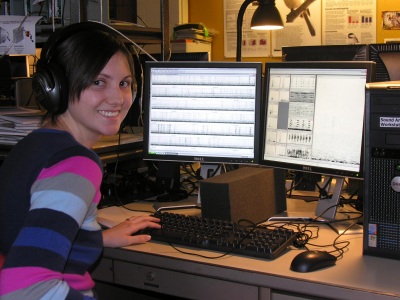 So today's web update is a salute to the sound analysis team, especially Katie Rieveley, and a promise that I won't forget her again. |
|||||||
|
SATURDAY
JANUARY 20, 2007
The Secret Underground Lair of the Ivorybill Adventures in uploading continue for the Ivory-billed Bioacoustics Team. The technology group at the Walton County Courthouse have been tremendously helpful in allowing us to upload sounds to my laboratory at the University of Windsor. However, the operating hours at the courthouse are limited to weekdays. So, the good people at the courthouse came up with the perfect solution: we can now upload sounds every day of the week from the city's Emergency Operating Center. The operations center is an underground facility that houses all of the emergency services for Walton County. The building is storm-proof, and has the feeling of a secret subterranean bunker. Because the center operates 24/7, we can uploading our recordings from the Choctawhatchee late each afternoon on both weekdays and weekends. Karan and Justyn are moving full steam ahead, streaming sounds to Windsor. The analysis team is fulfilling their end of the bargain, scanning sounds each day. Now if the Ivorybills would just fly near our microphones and produce some double knocks or kent calls! |
|||||||
|
WEDNESDAY
JANUARY 17, 2007
Courthouse to the Rescue Since we began the 2007 Ivory-billed Woodpecker Search, the Bioacoustics Team has been plagued by one major problem: Bandwidth. Every day, Karan, Justyn, and I record tens of gigabytes of sound data on the Choctawhatchee River using our automated Listening Stations. Meanwhile, Kyle and the sound analysis team wait in my sound analysis laboratory at the University of Windsor, ready to scan the recordings for woodpecker sounds. How can we rapidly transmit such large quantites of data from Florida to Windsor? At our field house in Defuniak Springs we ordered the fastest internet connection we could find. Unfortunately, with 2 megabits per second upload speed we could transmit only half of what we recorded on any given day. We needed more speed. After many calls to our Internet Service Provider, and lots of good advice from the Information Technology team at the University of Windsor, I realized that we were not going to improve our upload speed from our field house. So, I began to look elsewhere in the Defuniak Springs community. I found out that the Walton County Courthouse has the fastest internet connection in town and I began a phone campaign to find out if we could use their internet connection during off hours. I'm delighted to report that, as of 4:15 PM this afternoon, we are uploading recordings from the Walton County Courthouse! Their upload speed is quite fast, and when we combine the uploads from the courthouse with the uploads from our field house, we will be able to acheive our goal of 24-hour turnaround on analysis of recordings from the 16 Listening Stations on the Choctawhatchee. We are very thankful to the staff of the Walton County Courthouse for helping us in our search for Ivory-billed Woodpeckers. |
|||||||
| MONDAY JANUARY 15, 2007 What's in a Listening Station? Our search for sound
evidence of the Ivory-billed Woodpecker in 2007 relies on sixteen
Listening Stations. The Listening Stations record from places
throughout the Choctawhatchee River's bottomland forests and the
recordings are sent to the Mennill Sound Analysis Laboratory at the
University of Windsor for analysis on a nightly basis.
Each Listening Station
uses a Sennheiser ME62 omni-directional microphone. These
sensitive microphones record sound from 360 degrees around each
listening station. To protect the microphone from rain, I build
PVC-tube housings with a mesh screen cover, and suspend the microphone
in its housing from a tall wooden stake via a metal shelf bracket.
The microphone is connected to a Marantz digital recorder (below, at right) which records information as MP3 sound files. To keep the digital recorders running for 24 hours at a time, we use rechargable sealed lead acid batteries (below, at left). The batteries are heavy and they give the field team a good workout as we carry them around the swamp. To support our search, Marantz Canada donated five recording units. The
battery and the recorder are both housed in a waterproof dry bag, which
we hang around the base of the microphone tree. We lash the microphone
pole to a small tree with bungee cords.
The whole apparatus gets
a solid dose of green, brown, and black spray paint to camouflage it,
both from Ivory-billed Woodpeckers and hikers and hunters in the woods.
|
|||||||
| SATURDAY JANUARY 13, 2007 The Search Begins The 2007 search for
Ivory-billed Woodpeckers on the Choctawhatchee River in the Florida
Panhandle is now underway. On
January 3, my graduate student Kyle Swiston and I loaded up the new
Mennil/Norris Lab field vehicle with recording gear and camping
supplies. I made the
long
drive south to the Florida panhandle to rendezvous with my
collaborators from Auburn University.
As with last year's
search, the 2007 search is a
collaborative effort between Dr. Geoff Hill (Auburn University) and
myself (University of Windsor). Geoff and his two graduate
students, Brian Rolek and Rusty Ligon, are coordinating a large scale
inventory of the cavities and foraging sign throughout the
Choctawhatchee River basin. Brian and Rusty have recruited an army of
dedicated technicians and volunteers, including some outstanding and
highly motivated ivorybill
searchers.
The field team has also
been encountering birds. The highlight of our observations from this
year's search was Tyler Hicks' encounter with a female Ivory-billed
Woodpecker on Christmas Eve. Following double knocks and kent calls,
Tyler observed a perched female Ivory-billed Woodpecker, and got a
clear look at the bird's black crest, ivory-white bill, and white lower
back. My bioacoustic team consists of both a field crew and a laboratory crew. Kyle Swiston leads the laboratory crew, including a throng of sound analysis technicians working in the Mennill Sound Analysis Laboratory on campus at the University of Windsor. Karan Odom and Justyn Stahl comprise the field team. Karan and Justyn are in charge of deploying 16 Listening Stations along the Choctawhatchee River. Each day they visit the Listening Stations, change the batteries, and retrieve memory cartridges containing recordings to send to Canada. You can see pictures of the 2007 team here. The goal of the 2007 Bioacoustic surve is to collect recordings on a daily basis, send them to the Mennill Sound Analysis Laboratory in Windsor, and scan the recording within 24 hours of recording. The lab team then phones the field team to tell them where the birds have been in the preceding 24 hours. This kind of 24-hour turnaround in a massive collection of recordings is difficult and unprecendented. However, our recording effort has already begun to yield rewards. On the first day of recording, we recorded a double knock at Listening Station #3! Stay tuned to this website for more news from the bioacoustics search team. |
|||||||
 |
 |
 |
 |
 |
 |
 |
 |
| Back to the top | |||||||
 |
|||||||
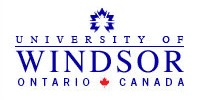 |
 |
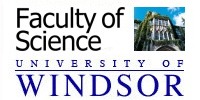 |
 |
 |
|||
 |
 |
 |
 |
 |
 |
 |
 |
|
All information on this
website is
copyright Daniel Mennill.
No information on this page may used without explicit permission (dmennillATuwindsorDOTca). |
|||||||
